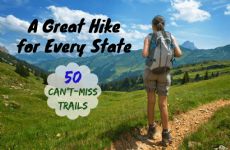|
Last Sunday, I reveled in the first day of spring by going for a hike at a nearby park. It was sunny and 60 degrees—perfect hiking weather! I'm always a little nervous when I hit the trail by myself because you never know what could happen. That's why it's best to come prepared. Whether you're heading out for a few hours or a few days, there are a few essentials that I never leave home without. These items make the trail so much happier. 1. Hiking Boots When you're hiking on a trail, a good pair of hiking boots is essential. Not only will they keep your feet dry and warm, but they are designed for maximum support and traction. You'll encounter a lot of different surfaces on a trail: grass, mud, water, rocks, gravel, puddles, downed trees and more. And unlike a paved sidewalk or road, the uneven terrain can make your footwork a little shakey. To help protect your ankles and feet in these conditions, good hiking boots rise higher on the leg than a standard shoe does, helping reduce injury risk and make your trek more comfortable. Hiking boots can be expensive, but you'll be so glad you made the investment. My boots got me to the bottom of the Grand Canyon and back up, and still have plenty of hikes left in them. 2. Good Socks For hiking, a good pair of socks should be breathable, yet insulating and water-repelling. I've said it before and I'll say it 100 more times, but wool socks are my go-to for all kinds of workouts because of these properties. Get a taller pair of socks than your shoes, hopefully ones with a little extra cushioning for your foot. My favorites are SmartWool hiking socks, which start out at about $14 per pair. Less costly socks with similar properties are made out of synthetic materials (instead of wool), and are still better than cotton, which can hold in moisture and result in blisters. 3. A Hat I'm not one for exercising in hats, but I do love a good sun hat when I'm going to be hiking for a while. A wider brim will keep sun off your face, and also be good in a pinch if it starts to rain. 4. Water Bottle and Snack If I know my route and know that I shouldn't be gone for longer than an hour, I usually bring a reusable Sigg bottle that I fill up at home before I go. Some trails have water pumps that provide safe and clean drinking water, but you can never be too careful; sometimes these pumps don't work or aren't available. Most mainstream water bottles with water filters are made for tap water, not untreated spring water. If you do want to drink water on a trail, you'll need something different entirely: a fancy water purifier and/or water purifying tablets. If you're going to be out for a few hours, bring a snack like a small energy bar, apple, homemade trail mix or some nuts. I'm a big fan of the CLIF Mojo bars since they're not as sweet as many other energy bars. If you're hiking for exercise or trying to manage your weight, however, consider whether you'll really need a snack. Yes, hiking is a little more intense than casual walking, but most people don’t stop to refuel in the middle of a typical workout. Take snacks only if you'll be gone for several hours, or bring a snack as a backup plan in case you end up being gone longer than you planned. 5. Navigation I have no sense of direction, so I make it a point to look for maps of any trail I'm going to take and bring them with me, if possible. If you're headed to a new trail, bring some form of navigation (your smartphone, a navigation app, a compass and/or a paper map) and know how to use it. Many public trails are well marked, but it's easy to get turned around in the woods. Safety first! 6. Convertible (Zip Away) Pants Even in warmer weather, long pants are a good idea for hikes to help protect your legs from twigs, brush and other things you might run into as you go. But if you're taking a well-maintained trail, shorts can work just as well. My preference is a pair of convertible pants in a lightweight and breathable material. You can wear them long, roll them up (many have buttons to hold them up in that case) or zip off the pant legs to convert them to shorts. 7. Cell Phone This is simply a safety measure, but you should always have a backup plan. Depending on where you hike, you may or may not always have cell phone service. But when you do, it can be especially useful if you get lost, stay away longer than anticipated, get injured or run into trouble. Don't leave it in your car; bring it with you! 8. Trekking Poles Trekking poles are not a must-have, but if you plan to do a lot of hiking, they sure are nice! I used trekking poles on my Grand Canyon hike last spring, and they were a lifesaver—more like a leg saver! Not only are these good for balance and traction—great on rocky or dusty trails with inclines and declines or for anyone whose balance is a little off—but they also relieve your legs. By shifting some of your body weight into the poles, you take a lot of pressure off of your lower body joints. If you go for long hikes, or hike multiple days in a row, these can make all the difference in your ability to stick it out and stay comfortable. No fancy poles? You could also try a simple walking stick (or two) to get many of the same benefits. However, poles are much more ergonomic and easier to hold. 9. Backpack Now that you have all of these items to bring, how do you carry them? The answer: your backpack! If you're just bringing a few lightweight items, take any pack that is comfortable for you. Only if you're carting a lot of weight (more than a dozen pounds) would you need a specially designed backpack for hiking. These packs better distribute the weight you're carrying over your hips to relieve your shoulders, plus they're also completely adjustable for the most comfortable fit for you. 10. A Friend Why? The buddy system, of course! There's safety in numbers, but hiking with a friend can also be more fun. In a pinch, if I don't have a friend to bring, I bring my four-legged buddy with me. Ginger loves to hike, and she makes me feel a little safer than if I were out on my own. The exercises and outdoor time is good for both of us! For more tips to start hiking, from finding a hiking trail to staying safe, check out this article: Hike Yourself Fit. How many of these items do you bring when you hike? What other items would you add to the list? We hope you love these products as much as we do! SparkPeople may collect a small percentage of revenue from the links on this page |
Related Entries
More From SparkPeople
|







.jpg)















